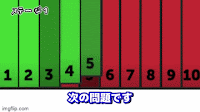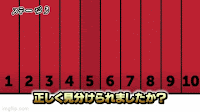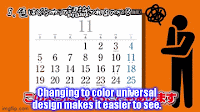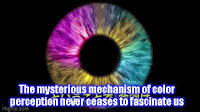Tetrachromatic color vision
We usually recognize colors as a matter of course.
For example, the sky is blue and leaves are green.
It is said that a person can distinguish 1,875,000 colors in a healthy state and up to 7,500,000 colors under certain conditions.
So, aren't you curious to know how well you can distinguish colors?
Let's take a color vision test to measure your ability to distinguish colors.
Today's topic is about the hidden power of the eyes.
The color vision test is a simple way to check how well you are able to distinguish colors.
There are three stages of questions, and for those who can answer all of them correctly, there is a special stage that is one more level higher.
There will be 10 colored bars and you have to choose one of a different color from them.
There are 10 questions in total. It seems that only about 8% of the respondents can answer all of them correctly. Are you one of them?
How well can you distinguish colors in a "color vision test"?
Let's take a look.
Stage 1
Which color is the only one different from the others?
Please choose one by its number.
The correct answer is number 5. I think this is pretty easy to understand.
Now the next question.
What is the number of the only one with a different color?
This is also quite easy to understand, isn't it?
The answer is number 3.
Now the last question of Stage 1.
Did you understand this one?
The correct answer is number 7.
It is said that 96% of the participants can answer all the questions in Stage 1.
You are still at the warm-up level.
Next, let's move on to Stage 2. The difficulty level will increase a little.
Please look at it carefully.
Stage 2
Now which ones are different colors?
Isn't this still easy to understand?
For 5 seconds
The answer is number 8.
Let's keep going at this pace.
5 seconds
It may be a little difficult to tell the color, but the correct answer here is number 5.
Now, the last question of Stage 2. Please look at it carefully.
For 5 seconds
Did you notice the difference in color?
The answer is number 1.
It is said that those who can answer all the questions up to this point correctly have normal eyesight.
By the way, it is said that only about 50% of the participants can correctly answer up to stage 2.
Next, let's move on to Stage 3. It will become more difficult at once, so please take a good look at it.
Stage 3
Now, it is time to move on to Stage 3.
First, let's look at the first question.
You have 5 seconds.
Can you see the difference in color?
Compared to Stage 1 and 2, this stage seems to be more difficult. The correct answer is number 5.
Did you distinguish them correctly?
Can you see the subtle difference in green?
5 sec.
The correct answer is number 7.
Now let's go to the last question.
Special stage is waiting for those who can clear this one.
Let's get fired up!
You have 5 seconds.
What do you think?
The correct answer is number 9.
At first glance, the colors look the same, but if you look closely, you can see that the colors are slightly different.
It is said that only about 30% of the participants will be able to clear stage 3.
It must have been quite difficult to get to this point.
Special Stage
If you have figured out stages 1 through 3, try the special stage.
Please try the special stage as well. It is said that only 8% of the respondents can understand this question.
Unlike before, there are only four choices, so look carefully.
It might be easier to see if you wipe your computer or smartphone screen well.
Now there are four green squares in a row, but one is a slightly different color.
For 5 seconds
Did you get it?
The correct answer is the leftmost square. If you look closely, you can see that it is slightly lighter in color than the other three.
Did you get this far?
If you got it perfect, you have a very high level of color vision.
In fact, most people cannot answer this question.
The more you can answer this test, the more colors you recognize.
How are colors perceived?
How do we perceive colors in the first place?
Basically, the world we live in is made up of three colors. When we recognize these three colors, we use "cone cells," which can distinguish about 100 different colors, including shades of color.
Combined, multiplied by 100 times 100, this means that we recognize 1,000,000 colors.
In the previous test, we checked how well we could distinguish shades of red, green, and blue.
Most people use three types of cone cells to distinguish colors, but some people have only two types of cone cells, in which case they see colors differently again.
If you have only two cone cells, the number of colors is 100 times 100, which is about 10,000 colors.
For example, it is said that it is difficult to distinguish red from green, orange from yellowish green, green from brown, blue from purple, and pink from white.
A simple example is signals.
Signals are seen completely differently by those with normal color vision and those without normal vision.
In the figure, people with normal color vision see a blue light as blue, but other people see a blue light as white or cannot distinguish a red or yellow light.
This is a great possibility for a traffic accident. For this reason, color universal design has recently been introduced to make it easier for people to distinguish colors.
For example, take a look at this calendar.
It is a very common calendar with weekdays in black, Saturdays in blue, and Sundays and holidays in red.
You may have one of these calendars in your home, but it is difficult for some people to see it, and it may look like this.
If this is changed to color universal design, it will look like this.
By changing red to bright vermilion and drawing red lines on holidays to make them easier to see, people with color weakness will be able to see them like this.
Now it is easier to recognize holidays and weekends.
Also, the letters have been made bold so that the elderly and people with poor eyesight can see them.
There are other signs that warn of danger. Take a look at this.
This image may look like this to some people.
The off-limits text blends in with the black background, making it a little difficult to read.
Here is an improved version.
Just by changing the arrangement of the colors a little, the design becomes easy to read for people with color weakness.
The most common type is trichromatopsia, but some people have tetrachromatopsia, and it is said that these people can see more than 100 million colors, 100 times more than trichromatopsia.
These people are said to be able to see more than 100 million colors, which is 100 times more than trichromatopsia.
This story shows that the perception of color differs from person to person, but as we go back in time, we can see the mysteries of color.
However, as we go back in time, there is still no end to the mysteries surrounding color.
One such mystery is how we perceive blue.
Ancient people could not recognize blue
What do you think of when you hear the word "major colors"?
Red, blue, yellow, green, and white are probably the most common.
In fact, a linguist is of the opinion that humans may not have been able to recognize the color blue in the past, even though we take it for granted.
In fact, a linguist has suggested that humans may not have been able to recognize the color blue in the past.
The sky is the most common example of blue. Blue is therefore a color that is familiar to humans.
So why was blue thought to be unrecognizable?
The clue is found in the Odyssey, a famous book of world history written in the 8th century BC.
As far back as 1858, William Gladstone, who later became a British minister, analyzed the Odyssey of Homer.
He counted the words for colors in the book and found that blue did not appear even once.
By the way, black appeared almost 200 times, white about 100 times, and yellow and green about 10 times.
about 10 times for yellow and green.
He says that he used the word white-dark for the color blue to describe the color of the ocean.
What a surprise, there is no word in the book to describe the color blue at all. This tells us that the ancients had no concept of blue.
But this alone makes you think that it is a matter of Homer's expression. But this was not limited to Greek mythology.
The word "blue" does not appear even once in the Koran, the Islamic holy book, ancient Chinese stories, or the Hebrew version of the Bible.
And even today, some ethnic groups are said to have no concept of the color blue.
What is the Himba tribe, a people for whom blue does not exist?
The Himba people are an ethnic group living in northern Namibia, Africa.
It is said that in their culture there is no word for blue.
One researcher conducted such an experiment.
Can you guess which one is a different color from the rest?
Do you know which one is the one in the upper left corner? I think most people can recognize it at once.
However, the Himba could not understand the difference from the surroundings because they could not recognize the color blue, which clearly stood out from the surroundings. Even when we explained to them that it was a different color, it took them a long time to recognize it.
This experiment showed that the Himba have difficulty perceiving the color blue.
Of course, this is not a matter of color blindness, but of cultural differences.
Now look at the next problem.
Can you recognize one of the pictures that is a different color?
The answer is the upper left square.
I think this was quite difficult to distinguish, but to my surprise, the Himba people were able to identify it in one shot.
It is said that there are countless words for green in the Himba language. However, there is not a single word for blue.
Perhaps this is a result of the Himba people's living in a place with a lot of greenery.
So, in this article, I have investigated the color vision test and the mysterious color system.
We have learned that there are many things in this world that our common sense and usual knowledge cannot be understood when we take a step out of the box.
You can live without knowing, but it may be useful to know.
It is up to you to know or not to know.
*Since it is translated by the author of the article, it may differ from what is said in the video.









![[Free Shipping] ROHTO VRohto Premium For Eyestrain (15mL) x 3set From Japan [Free Shipping] ROHTO VRohto Premium For Eyestrain (15mL) x 3set From Japan](https://blogger.googleusercontent.com/img/b/R29vZ2xl/AVvXsEhCBW-sa2a8UMh1DmLDqXQVSNrIYvcQR6KSfk3wjcu3HL_NVi4s1weoJjxq3ELI1Q021p-qQ8ySEY97YMewqglVFcDJzjY5BAfrTjK61Nc9RWpEwQTs6BAv5Wa_oz2QfGyHwGZ8Zuawcm0f5MZz9W6HNNN0uPfiggc9tInu8h1YlwnOvJAyWXriEQHowQ/w320-h320/VRohtoPremium3set%E3%82%A4345%C3%97345%20%E7%99%BD%E6%9E%A012.png)
